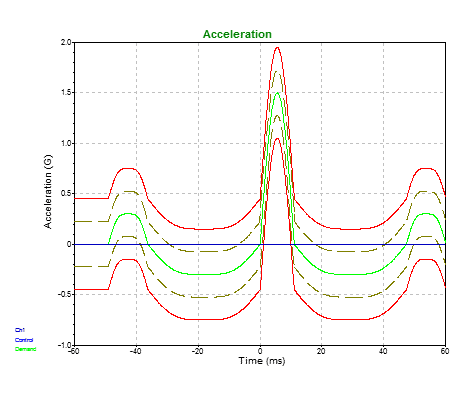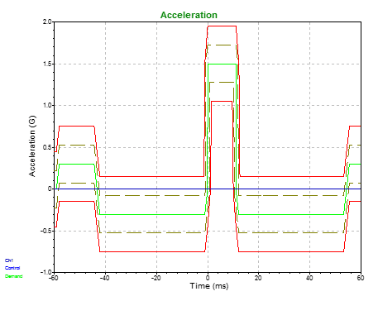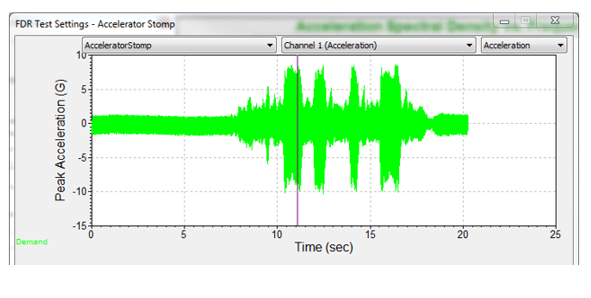Test Types: Shock, Mixed Mode & FDR
March 29, 2018
Background
Using VibrationVIEW
Laboratory Exercises
Reference
Back to: VibrationVIEW Syllabus
Shock Tests
Whether it be gunfire, explosions, or large potholes, many products experience shock pulses over their lifetime. Today, many industries use shock tests to make sure their product can withstand not only typical use but also more extreme accelerations.
A shock test is a time-domain test. Shock tests apply peak amplitude shock pulses over a particular time duration. The shock pulses are then repeated for a designated time interval or pulse count. With VibrationVIEW, a user can choose from a number of different shock waveforms including half-sine, triangle, trapezoid, square, and more (see Figures 2.14 and 2.15.)

Figure 2.14. Shock pulse (sine wave).

Figure 2.15. Shock pulse (square wave).
Shock tests are often required by MIL-STD. Although shocks may not occur frequently, they are an expected occurrence. For example, a gunfire test is required for military vehicles. These vehicles have turrets that hold large-caliber machine guns. When fired, the weapons cause shocks to run through the entirety of the vehicle. If not properly tested, the damage caused by the shocks could permanently damage the vehicle.
Shock Response Spectra (SRS)
Shock tests expose a product to regular shock pulses of a prescribed acceleration in the time domain. In comparison, SRS exposes the product to shock pulses of various accelerations in the frequency domain. In other words, an SRS is a set of shock pulses with different acceleration values at every frequency in a particular frequency range. With an SRS, an engineer can design a test that applies different shock pulses to the product at different frequencies.
User-Defined Transient
User-Defined Transient is a tool for recreating transient events that have been recorded in the real world. It is also used to create a sine burst or sine chirp transients, which are required by some specifications. Weapons sight and optics manufacturers use this method to replicate the transient event that affects the sight when the weapon is fired.
Transient Capture
Transient Capture is a data acquisition tool that captures a transient waveform for post-processing. Most often, it is used with SRS to analyze each pulse as it is captured.
Mixed Mode Testing
Mixed-mode testing is a combination of sine and random vibrations performed simultaneously to simulate sources where both modes are present. Mixed-mode testing has been shown to better simulate a real-world environment than sine or random vibration separately.
There are many sources of vibration in the real world. In order to better replicate this in the lab, it is necessary to combine sine and random vibrations into a single test profile. The following are several types of mixed-mode tests.
Sine on Random (SoR)
SoR tests are very common. The helicopter gunfire test is a testament to the importance of an SoR test. A helicopter is constantly subject to random vibration: the vibration of the engine, the rotors cutting through the air, and the movement of the entire body against the air. Cyclic gunfire has a distinct sinusoidal vibration; when a weapons system is mounted to the frame of a helicopter, the sine tones are introduced into the structure of the helicopter on top of the pre-existing random vibration. The cyclic gunfire is not a constant vibration, but it has a high acceleration value that must be considered when testing. An SoR test can be used to closely represent this real-world environment and make sure the products can withstand the harsh changes caused by gunfire during flight.
Random on Random
Random on Random is another common occurrence when closely simulating real-world vibration. An airplane propeller serves as an excellent example for random on random vibration. The noise generated by the engine is sinusoidal, but as that noise and all the harmonics travel further from the engine they begin to “smear” causing random bandwidths of noise rather than purely sinusoidal. Random on Random allows the engineer to build a test profile that includes the broadband spectrum of energy while including the narrowband spectrums of higher energy caused by the engine noise and its harmonics.
Sine and Random on Random
Sine and Random on Random is a more complex version of the previous examples. Although more complex, this test mode gives the engineer the ability to make changes to specific portions of the random energy.
Field Data Replication (FDR)
Field data replication is a method of recording real-world data and “replicating” the data on the shaker. FDR tests are similar to a shaped random test because the spectrum is the same as the real application.
This method is realistic but has shortcomings. It is often difficult to record a representative waveform, especially in the aerospace industry. A waveform only represents a specific product in a particular situation and, more than likely, it does not represent the entire life of the product (Figure 2.16).

Figure 2.16. Accelerator stomp FDR waveform.
